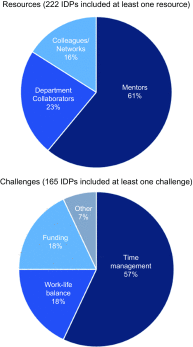Building a comprehensive mentoring academy for schools of health
- PMID: 31660245
- PMCID: PMC6813514
- DOI: 10.1017/cts.2019.406
Building a comprehensive mentoring academy for schools of health
Abstract
Formal mentoring programs are increasingly recognized as critical for faculty career development. We describe a mentoring academy (MA) developed for faculty across tracks (i.e., researchers, clinicians, educators) within a "school of health" encompassing schools of medicine and nursing. The program is anchored dually in a clinical and translational science center and a school of health. The structure includes the involvement of departmental and center mentoring directors to achieve widespread uptake and oversight. A fundamental resource provided by the MA includes providing workshops to enhance mentoring skills. Initiatives for junior faculty emphasize establishing and maintaining strong mentoring relationships and implementing individual development plans (IDPs) for career planning. We present self-report data on competency improvement from mentor workshops and data on resources and barriers identified by junior faculty (n = 222) in their IDPs. Mentors reported statistically significantly improved mentoring competency after workshop participation. Junior faculty most frequently identified mentors (61%) and collaborators (23%) as resources for goal attainment. Top barriers included insufficient time and time-management issues (57%), funding limitations (18%), work-life balance issues (18%), including inadequate time for self-care and career development activities. Our MA can serve as a model and roadmap for providing resources to faculty across traditional tracks within medical schools.
Keywords: Workforce development; dissemination and implementation; goal setting; individual development plans; mentor training.
© The Association for Clinical and Translational Science 2019.
Figures


Similar articles
-
Independent investigator incubator (I3): a comprehensive mentorship program to jumpstart productive research careers for junior faculty.BMC Med Educ. 2018 Aug 6;18(1):186. doi: 10.1186/s12909-018-1290-3. BMC Med Educ. 2018. PMID: 30081899 Free PMC article.
-
Mentoring Early-Career Faculty Researchers Is Important-But First "Train the Trainer".Acad Med. 2016 Dec;91(12):1598-1600. doi: 10.1097/ACM.0000000000001264. Acad Med. 2016. PMID: 27332872 Free PMC article.
-
Mentor training for junior faculty: a brief evaluation report from the Georgia Clinical and Translational Science Alliance.J Investig Med. 2023 Aug;71(6):577-585. doi: 10.1177/10815589231168601. Epub 2023 Apr 21. J Investig Med. 2023. PMID: 37085987 Free PMC article.
-
Mentoring New and Early-Stage Investigators and Underrepresented Minority Faculty for Research Success in Health-Related Fields: An Integrative Literature Review (2010-2020).Int J Environ Res Public Health. 2021 Jan 7;18(2):432. doi: 10.3390/ijerph18020432. Int J Environ Res Public Health. 2021. PMID: 33430479 Free PMC article. Review.
-
Work-Life Balance: The True Failure Is in Not Trying.Front Pediatr. 2016 Apr 28;4:37. doi: 10.3389/fped.2016.00037. eCollection 2016. Front Pediatr. 2016. PMID: 27200320 Free PMC article. Review. No abstract available.
Cited by
-
Sciducio: a practical framework for guiding the development and leadership of the academic research environment.Front Res Metr Anal. 2023 Oct 9;8:1205874. doi: 10.3389/frma.2023.1205874. eCollection 2023. Front Res Metr Anal. 2023. PMID: 37876577 Free PMC article.
-
Faculty Development for Academic Emergency Physicians: A Focus Group Analysis.Cureus. 2022 Aug 2;14(8):e27596. doi: 10.7759/cureus.27596. eCollection 2022 Aug. Cureus. 2022. PMID: 36059367 Free PMC article.
-
A system-wide health sciences faculty mentor training program is associated with improved effective mentoring and institutional climate.J Clin Transl Sci. 2021 Dec 23;6(1):e18. doi: 10.1017/cts.2021.883. eCollection 2022. J Clin Transl Sci. 2021. PMID: 35291213 Free PMC article.
-
Clinical and translational science award T32/TL1 training programs: program goals and mentorship practices.J Clin Transl Sci. 2021 Dec 27;6(1):e13. doi: 10.1017/cts.2021.884. eCollection 2022. J Clin Transl Sci. 2021. PMID: 35211339 Free PMC article.
-
Coaching tailored by stages: A valuable educational strategy to achieve independence in research.J Clin Transl Sci. 2021 Jun 18;5(1):e141. doi: 10.1017/cts.2021.804. eCollection 2021. J Clin Transl Sci. 2021. PMID: 34422321 Free PMC article.
References
-
- Palepu A, et al. Junior faculty members’ mentoring relationships and their professional development in U.S. medical schools. Academic Medicine 1998; 73(3): 318–323. - PubMed
-
- Eby LT, et al. An interdisciplinary meta-analysis of the potential antecedents, correlates, and consequences of protege perceptions of mentoring. Psychological Bulletin 2013; 139(2): 441–476. - PubMed
